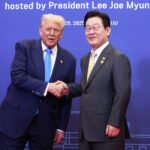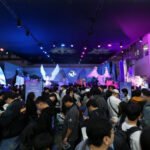 |
Every November, South Korea comes to a standstill for its infamous college entrance exam. Shops are shut, flights are delayed to reduce noise, and even the rhythm of the morning commute slows down for the students. By late afternoon, most test-takers walk out of school gates, exhaling with relief and embracing the family members waiting outside. But not everyone finishes at that hour. Even once darkness has fully settled and night has set in, some students are still in the exam room – finishing close to 10pm. They are the blind students, who often spend more than 12 hours taking the longest version of the Suneung. On Thursday, more than 550,000 students across the country will sit for the Suneung – an abbreviation for College Scholastic Ability Test (CSAT) in Korean. It is the highest number of applicants in seven years. The test not only dictates whether people will be able to go to university, but can affect their job prospects, income, where they will live and even future relationships. Depending on their subject choices, students answer roughly 200 questions across Korean, mathematics, English, social or natural sciences, an additional foreign language, and Hanja (classical Chinese characters used in Korean). For most students, it is an eight-hour marathon of back-to-back exams. They begin the Suneung test at 08:40 and finish around 17:40. Blind students with severe visual impairments, however, are given 1.7 times the standard testing duration. This means that if they take the additional foreign language section, the exam can finish as late as 21:48 – nearly 13 hours after it began. There is no dinner break; the exam continues straight through. The physical bulk of the braille test papers also contributes to the length. When every sentence, symbol and diagram is converted into braille, each test booklet becomes six to nine times thicker than the standard equivalent. At Seoul Hanbit School for the Blind, 18-year-old Han Donghyun is among the students who will take the longest version of the Suneung this year. Last year, there were 111 blind test-takers nationwide – 99 with low vision and 12 with severe visual impairments like Dong-hyun – according to data from the Ministry of Education and the Korea Institute for Curriculum and Evaluation. Dong-hyun was born completely blind and cannot distinguish light. When the BBC met him at his school on 7 November, his fingers moved quickly across a braille practice booklet of past exam questions. With just a week left before the test, he was focused on managing his stamina and condition. Dong-hyun will take the exam using braille test papers and a screen-reading computer. “It’s really exhausting because the exam is so long,” he said. “But there’s no special trick. I just follow my study schedule and try to manage my condition. That’s the only way.” Dong-hyun said the Korean language section is particularly difficult for him. A standard test booklet for that section is about 16 pages – but the braille version is roughly 100 pages long. Even with screen-reading software, spoken information disappears as soon as it is heard, unlike text that can be seen and re-read. Dong-hyun has to hold the details in his memory as he goes. The mathematics section is no easier. He must interpret complex graphs and tables that have been converted into braille, using only his fingertips. Still, he noted that things are better than they used to be. In the past, students had to do almost all calculations in their heads. But since 2016, blind test-takers have been allowed to use a braille notetaker, known as Hansone. “Just like sighted students write out their calculations in pencil, we enter them in braille on the Hansone to follow the steps,” he said. Another student at Hanbit School for the Blind, 18-year-old Oh Jeong-won, who will also sit the Suneung this year, said the late afternoon is “the hardest point” of the day. “Up until lunch, it’s manageable,” he said. “But around 4 or 5pm, after English and before Korean History, that’s when it gets really tough. “There’s no dinner break,” he explained. “We’re solving problems during the time we would normally eat, so it feels even more exhausting. Still, I keep going because I know there will be a sense of accomplishment at the end.” For Jeong-won, the fatigue is compounded by the need to stay intensely focused with both his hands and his hearing. “When I’m reading the braille with my fingers and also taking in information through audio, it feels much more tiring than it does for sighted students,” he said. But the students say that the length of the exam and the long study hours are not the hardest part. What is most challenging is access to study materials. Popular textbooks and online lectures that sighted students rely on are often out of reach. There are very few braille versions, and converting materials into audio requires having text files – which are difficult to obtain. In many cases, someone has to manually type out entire workbooks to make them usable. Online lectures also pose difficulties, as many instructors explain concepts using visual notes, diagrams and graphics on screen, which cannot be followed through audio alone. One of the most significant barriers, however, is the delay in receiving braille versions of the state-produced EBS preparation books – a core set of materials closely linked to the national exam. Because of this delay, blind students often receive the materials months later than others. “Sighted students get their EBS books between January and March and study them for the whole year,” said Jeong-won. “We receive the braille files only around August or September, when the exam is just a few months away.” Dong-hyun shared the same concern. “The braille materials weren’t completed until less than 90 days before the exam,” he said. “I kept wishing the publication process could be faster.” The National Institute of Special Education, which produces the braille version of EBS exam materials, told the BBC that the process takes at least three months for each book because it must follow relevant guidelines. The institute added that it is “making various efforts to ensure that blind students can study without disruption, such as producing and providing the materials in separate volumes.” The Korean Blind Union said it has long raised this issue with authorities, and plans to file a constitutional petition demanding greater accessibility to braille versions of all textbooks. For these students, the Suneung is not just a college entrance exam – it’s proof of the years they have endured to get where they are. Jeong-won described the exam as “perseverance.” “There’s almost nothing you can do in life without perseverance,” he said. “I think this time is a process of training my will.” Their teacher, Kang Seok-ju, watches students go through the exam every year – and said the blind students’ endurance is “remarkable”. “Reading braille means tracing raised dots with your fingertips. The constant friction can make their hands quite sore,” he pointed out. “But they do it for hours.” Mr Kang urged his students to value completion rather than regret. “This exam is where you pour everything you’ve learned since the first grade into a single day,” he said. “Many students feel disappointed afterwards, but I just want them to leave knowing they did what they could. “The exam is not everything.” submitted by /u/coinfwip4 |
Related Posts
Latest News from Korea
- Washington endorses Seoul’s nuclear submarine ambitions, slashes auto trafiffsSouth Korean President Lee Jae Myung (right) greets Donhald Trump at the APEC Summit in Gyeongju, Korea on Oct. 29, 2025 (Courtesy of Yonhap) South Korean President Lee Jae Myung said on Friday that the US has agreed to support Seoul’s long-held pursuit of nuclear-powered submarines and expanded authority over nuclear fuel processing as the two countries released the final… Read more: Washington endorses Seoul’s nuclear submarine ambitions, slashes auto trafiffs
- Hyundai Motor Group to build $2.7 bn EV mother factory in S.KoreaKia’s first PBV plant, the EVO Plant East, in Hwaseong, Gyeonggi Province, South Korea, opens on Nov. 14, 2025 (Courtesy of Kia) Hyundai Motor Group, the world’s third-largest automaker with 7.23 million vehicles sold last year, will invest 4 trillion won ($2.7 billion) to build an electric-vehicle mother plant in South Korea, a flagship facility that Seoul sees as essential… Read more: Hyundai Motor Group to build $2.7 bn EV mother factory in S.Korea
- NCSOFT bets big on AI, cloud with debut of Horizon universe-based MMORPGA long line forms for the AION 2 demo at the G-STAR 2025 booth on Nov. 14 NCSOFT Corp., a leading South Korean game developer and publisher, has unveiled Horizon Steel Frontiers, the first-ever MMORPG set in Sony Interactive Entertainment’s Horizon universe. The new title, rooted in the Horizon Zero Dawn franchise, marks NCSOFT’s strategic leap into AI-driven and cloud-based… Read more: NCSOFT bets big on AI, cloud with debut of Horizon universe-based MMORPG
- Defensive tilt, infrastructure surge set to lift Europe’s private debt market: BlackRockStephan Caron, managing director and global head of growth lending at BlackRock Heightened geopolitical uncertainty and the energy transition are fueling defense and infrastructure spending in Europe, positioning its private credit market for faster growth. As interest rates decline, growing refinancing demand and renewed M&A momentum are expected to galvanize the non-bank credit market, according to Stephan Caron, managing director… Read more: Defensive tilt, infrastructure surge set to lift Europe’s private debt market: BlackRock
- Seoul steps up verbal warning for won’s slide; to discuss with NPS for FX stabilityDeputy Prime Minister and Finance Minister Koo Yun-cheol (second from right) pose for a photo with other policymakers after a market-monitoring meeting on Nov. 14, 2025 (Courtesy of Yonhap) The South Korean won rebounded sharply from seven-month lows on Friday morning after authorities moved to steady the currency with a mix of verbal warnings and suspected dollar-selling. The won strengthened… Read more: Seoul steps up verbal warning for won’s slide; to discuss with NPS for FX stability
Latest Entertainment from Korea
- K-LAND 2026 WINTER K-POP CONTEST Announces Haru (former NATURE) & Yuuri (former LUNARSOLAR) as Judges — How to Apply OnlinePhoto Credit: K-Land The K-LAND 2026 WINTER K-POP CONTEST is making headlines this year with the announcement that Haru (formerly of NATURE) and Yuuri (formerly of LUNARSOLAR) will serve as special judges for the highly anticipated event. This online-only K-pop dance contest remains one of the largest and most inclusive global showcases for rising K-pop dancers, with participants submitting their best full-length dance covers… Read more: K-LAND 2026 WINTER K-POP CONTEST Announces Haru (former NATURE) & Yuuri (former LUNARSOLAR) as Judges — How to Apply Online
- BTS Jin Illuminates SPUR Magazine January 2026 Covers with FRED Jewelry: A Masterclass in Quiet Luxury and Contemporary ElegancePhoto Credits: SPUR Magazine FRED Jewelry BIGHIT MUSIC BTS’s Jin, ever the epitome of refined modernity, graces the covers of SPUR Magazine’s January 2026 regular and special editions, in a collaboration that perfectly melds his serene charisma with FRED Jewelry’s sophisticated craftsmanship. As the face of these covers, Jin effortlessly channels a “face economy” era – where minimalism meets magnetic… Read more: BTS Jin Illuminates SPUR Magazine January 2026 Covers with FRED Jewelry: A Masterclass in Quiet Luxury and Contemporary Elegance
- Stray Kids’ I.N Shines as Cosmopolitan Korea December 2025 Cover Star, Radiating Elegance with Damiani’s Luxe JewelryPhoto Credits: KQ Entertainment Cosmopolitan Korea Damiani Stray Kids’ I.N captivates as the December 2025 cover star of Cosmopolitan Korea, in a shoot highlighting his role as global ambassador for luxury Italian jeweler Damiani. The pictorial channels elegance and warmth through a minimalist yet festive lens, spotlighting Damiani’s Belle Époque, Margherita, and Mimosa collections, set against South Korea’s stylish winter… Read more: Stray Kids’ I.N Shines as Cosmopolitan Korea December 2025 Cover Star, Radiating Elegance with Damiani’s Luxe Jewelry
- ATEEZ’s Hongjoong Transforms Japanese Winter Fashion on the December 2025 Singles Magazine Cover: A Bold Statement in Style and Self-ExpressionPhoto Credits: Singles Magzine KQ Entertainment ATEEZ’s Hongjoong seizes the limelight as the December 2025 cover star for Singles Magazine Japan, presenting a compelling vision of high-fashion that explores both duality and daring self-expression. For this pivotal pictorial, Hongjoong does more than simply model: he embodies the restless creative force at the heart of K-pop’s runway revolution, blurring the lines… Read more: ATEEZ’s Hongjoong Transforms Japanese Winter Fashion on the December 2025 Singles Magazine Cover: A Bold Statement in Style and Self-Expression
- Stray Kids Felix Commands Vogue Korea December 2025 with Three Stunning Louis Vuitton Covers, a Milestone in K-Pop Fashion IconographyPhoto Credits: Vogue Korea Louis Vuitton JYP Entertainnent Stray Kids’ Felix makes an unprecedented fashion statement as the December 2025 cover star of Vogue Korea, appearing in not one, but three solo covers. This landmark moment crowns him as the first fourth-generation male K-Pop idol to secure a solo main print cover for Vogue Korea, underscoring his ascent as a… Read more: Stray Kids Felix Commands Vogue Korea December 2025 with Three Stunning Louis Vuitton Covers, a Milestone in K-Pop Fashion Iconography
Learn People & History of Korea
- The Evolution of Busan: A Historical Journey Through South Korea’s Second Largest Metropolitan CityAncient Beginnings: The Founding of Busan Busan, known as the second largest metropolitan city in South Korea, has a rich history that dates back to ancient times. The earliest recorded existence of Busan can be traced to the Goryeo Dynasty, where it was referenced as a vital coastal settlement. Its strategic location along the southeastern coast of the Korean Peninsula… Read more: The Evolution of Busan: A Historical Journey Through South Korea’s Second Largest Metropolitan City
- The Evolution of Pyongyang: A Journey Through History, Economy, and Political DynamicsIntroduction to Pyongyang Pyongyang, the capital city of North Korea, serves as a prominent symbol of the nation’s history and culture. Geographically located on the banks of the Taedong River, in the southwest part of the country, Pyongyang is situated within a strategic area that has historically facilitated trade and cultural exchange. The city’s origins can be traced back to… Read more: The Evolution of Pyongyang: A Journey Through History, Economy, and Political Dynamics
- The Evolution of Seoul: From Ancient Korea to Modern Metropolis and BeyondAncient Beginnings: The Founding of Seoul The city of Seoul, known today as the vibrant capital of South Korea, has ancient roots that trace back to the Three Kingdoms period of Korea, specifically the kingdoms of Baekje and Silla. Evidence suggests that Seoul was originally established as a settlement given its strategic geographical advantages. Nestled within the Han River basin,… Read more: The Evolution of Seoul: From Ancient Korea to Modern Metropolis and Beyond
- Exploring Korean Traditional Games in Squid Game: From Season 2 to Upcoming Season 3Introduction to Korean Traditional Games Korean traditional games have long been an integral part of the country’s cultural landscape, offering more than mere entertainment. These games, which range from simple children’s pastimes to complex community activities, hold significant cultural significance and often serve as a means of preserving history and promoting social interaction. Rooted in centuries of tradition, these games… Read more: Exploring Korean Traditional Games in Squid Game: From Season 2 to Upcoming Season 3
- Unveiling the Past and Present of Saju: The Art of Korean Fortune TellingIntroduction to Saju Saju, a traditional Korean fortune-telling practice, is an intricate art that seeks to interpret an individual’s fate based on their birth date and time. The term “Saju” translates to “four pillars” in English, referring to the four critical components derived from these time markers: year, month, day, and hour. This method holds significant cultural value within South… Read more: Unveiling the Past and Present of Saju: The Art of Korean Fortune Telling















